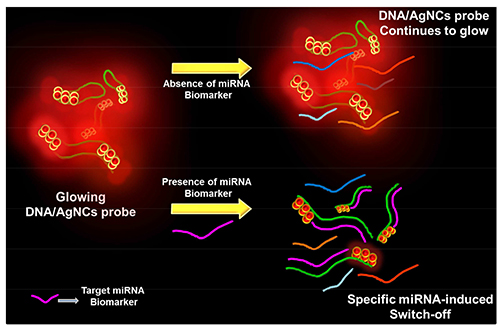PhD defense by Pratik Shah
Title of thesis: Rapid detection of miRNA using nucleic acids-templated AgNCs

Pratik Shah
Academic supervisor:
Associate Professor Seong Wook Yang, University of Copenhagen
Opponents:
Tim Yeh, The University of Texas at Austin
Dae-Jin Yun, Gyeongsang National University, South Korea

Principle of DNA/AgNC based microRNA detection method. Fluorescence of secondary structure forming DNA/AgNC sensor is dropped in the presence of specific target microRNA
SUMMARY
MicroRNAs (miRNAs) are small ubiquitous RNA molecules (20-24nt) that negatively regulate target gene expression at the post-transcriptional level. Due to their roles in a variety of biological processes, the levels of miRNAs are dynamically changed in response to cellular and environmental signals. In the case of plants, the levels of certain miRNAs can be used as biomarkers to evaluate the physiological status. Specific miRNA levels are influenced by stresses such as drought, salt, cold, heat and pathogenic infestations. In humans, the dysregulation of miRNAs have been highlighted in many diseases such as cancer, diabetes, cardiovascular disease and Alzheimer’s disease. MiRNAs, thus, can be useful markers for disease diagnosis, prognosis, and treatment. Because of its attractive optical properties such as brightness, tuneable emission wavelengths and photo-stability, DNA stabilized silver nano-clusters (AgNCs) has increasingly been used to create nanoscale bio-sensing systems for selective and specific detection of bio-molecules.
During the course of my Ph.D., I have focused on developing a novel diagnostic tool for miRNA detection using the fluorescent properties of DNA encapsulated AgNCs (DNA/AgNCs). I have showed that rapid, simple, sensitive and specific miRNA detection is possible. Two aspects of my research are 1) the implication of DNA secondary structure on the photoluminescence properties of DNA/AgNCs, 2) the development of a novel tool for miRNA detection in complex biological samples. In the former, I revealed that the mismatched secondary structures of DNA-templates are important for the rapid formation of bright red fluorescence. Further, I suggest that the chromatic properties of DNA/AgNCs are modulated not only by sequence but also by secondary structure of DNA-templates. Moreover, through detailed analyses using RNA/DNA chimera templates, I found a new parameter that may control the emissive AgNCs formation, i.e. the rotational freedom of backbones in nucleic acids.
With these findings, I have established new approaches for miRNA detection. Using the approaches, I identified a new component of miRNA biogenesis in plants. The successful detection of miRNAs in complex biological samples demonstrates the potential use of our method in human disease diagnostics using miRNA as a biomarker.
